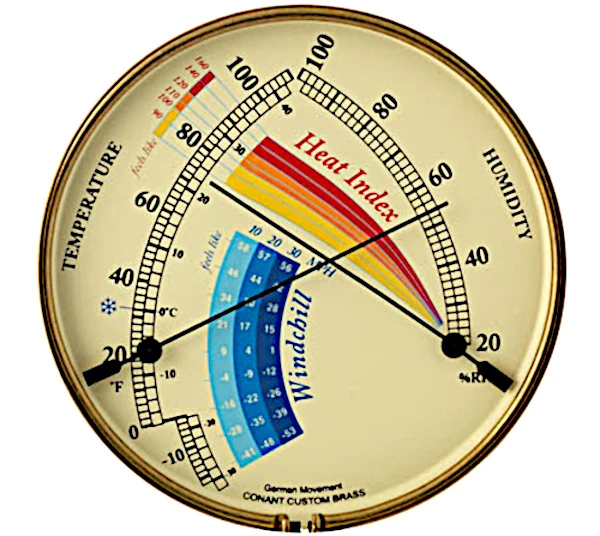
Image: Wind chill and heat index gauge that shows actual temperature as well as what it feels like. Creative Commons (Public domain).
The felt temperature, also called the wind chill index, takes into account the combination of actual temperature, wind speed, direct sunlight and relative humidity.
The human body generates heat due to metabolic processes (muscle activity, food digestion, blood circulation, etc.).
The felt temperature estimates the subjective sensation of cold perceived by the skin. It is calculated based on how different factors affect body heat loss. This heat loss is due to evaporation of sweat, conduction through the skin, and convection with air movement.
The stronger the wind, the more heat is dissipated, giving the impression of a lower temperature. The wind therefore accelerates the loss of heat from the body by convection. It removes the heated layer of air near the skin, thereby speeding up the cooling process. This can make you feel more cold, even if the ambient temperature is not extremely low.
Direct sunlight has a warming effect on the body. The stronger the sun, the higher the temperature felt. The warming effect of the sun is due to radiation. Indeed, the sun's rays pierce the atmosphere and penetrate the skin, which warms it.
At higher temperatures, high humidity can make feeling hot more uncomfortable. When it's hot, high humidity limits the body's ability to lose heat through sweating. Sweat has difficulty evaporating in air saturated with humidity. This can make you feel heavy and uncomfortable.
The commonly used mathematical formula is the National Weather Service (NWS) wind index.
Air movement accelerates the rate of heat transfer from a human body to the surrounding atmosphere, particularly when temperatures are below about 7°C (45°F).
The mathematical formula in units of the international system:
Tfelt = 13.12 + 0.6215 × T − 11.37 × V0.16 + 0.3965 × T × V0.16
T is the air temperature in degrees Celsius, measured 1.5 meters above the ground, in a shelter.
V is the wind speed in kilometers per hour.
13.12 is a constant term which takes into account certain physiological parameters, notably the heat produced by human metabolism.
0.6215 is a coefficient used to convert wind speed to units compatible with temperature in degrees Celsius.
11.37 is the coefficient associated with wind speed (V). It modifies the impact of wind on the sensation of cold by taking into account the variation in body heat loss with wind speed.
0.16 is an exponent used with wind speed in the formula. This exponent (0.16) represents the dependence of heat loss on wind speed. It indicates how the sensation of cold increases non-linearly with wind speed.
39.65 is a term that takes into account relative humidity. This means that humidity impacts how wind influences how cold you feel.
All these values are constant coefficients used to adjust the calculation of the felt temperature according to the actual temperature. These coefficients are derived from empirical research, meteorological studies and observations to improve the accuracy of the wind chill index by more realistically reflecting the effect of wind on temperature perception. By adjusting these coefficients, we seek to make the wind chill index more representative of the subjective reality of the sensation of cold in the presence of wind.
The mathematical formula in Anglo-Saxon units of measurement:
Tfelt = 35.74 + 0.6215 × T − 35.75 × V0.16 + 0.4275 × T × V0.16
Tfelt is the wind index in degrees Fahrenheit,
T is the air temperature in degrees Fahrenheit,
V is the wind speed in miles per hour.
Calculation in international system units:
T=5°C (actual temperature in degrees Celsius), V=40 km/h (wind speed).
Excel formula: = (13.12 + 0.6215 * 5) - (11.37 * 40^0.16) + (0.3965 * 5 * 40^0.16)
Temperature felt = 0.71°C.
Calculation in Anglo-Saxon units of measurement:
T=41°F (actual temperature in Fahrenheit), V=24.8 mph (wind speed in miles per hour).
Excel formula: = (35.74 + 0.6215 *41) - (35.75 * 24.8^0.16) + (0.4275 * 41 * 24.8^0.16)
Felt temperature = 41.9°F.
This seemingly complicated formula illustrates how wind increases heat loss from the body, making the temperature appear colder than it really is. The wind chill index therefore provides a more accurate measure of how cold you feel. But is the feeling general for all individuals?
The parameters chosen are average parameters, so the wind chill index formula provides a general approximation of the feeling of cold.
Indeed, individual perception of temperature can vary depending on several physiological, psychological and environmental factors. Things like body mass, activity level, blood circulation, metabolic rate, individual cold resistance, and even psychological aspects like personal cold tolerance can influence how a person experiences temperature.
Additionally, the formula does not take into account certain local factors such as exposure to sunlight, the presence of obstacles that could reduce wind speed, etc.
It is important to note that the temperature felt is a subjective concept. It depends on the individual's sensitivity to temperature, their equipment and their state of health.
The temperature felt by a naked human body in interstellar space depends on the thermal power released by the body, the temperature of the environment, and the mode of heat exchange. In general, the human body loses heat through convection, conduction and radiation.
In space, there is no convection or conduction, because there is no matter. The only mode of heat exchange is therefore radiation.
The human body emits infrared radiation with a wavelength of approximately 10 µm, which corresponds to a temperature of 37°C. The interstellar medium also emits radiation, the average temperature of which is -270.45°C. The temperature felt by the human body is therefore the difference between the temperature of the body and the temperature of the environment, multiplied by a heat exchange coefficient by radiation.
In reality, a human body exposed to the vacuum of space without protection would die within minutes, not from the cold, but from decompression, dehydration, asphyxiation and irradiation. We cannot therefore speak of felt temperature.